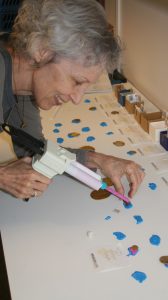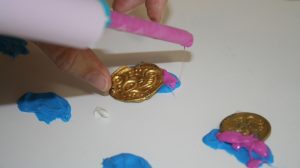OXFORD, Miss. – A University of Mississippi professor’s interest in Nordic art and culture is providing opportunities for her to conduct extended research at state, national and international levels.
Nancy L. Wicker is involved in three interrelated projects, all dealing with Viking and pre-Viking art and material culture of Scandinavia. During the 2016-17 academic year, the professor of art history will be on sabbatical to write a book about the people in Viking art. She will be in residence at the National Humanities Center at Research Triangle Park, North Carolina.
“I will examine the patrons and clients who sponsored the art, the artists and artisans who made the works, the men and women who used and viewed the objects, and also the humans or deities who were the subjects depicted in this art,” Wicker said. “I am among 37 fellows named from 449 applications submitted to the National Humanities Center this year.”
Wicker is also involved in an international collaborative project to create a free digital portal that will provide integrated access to collections of northern European art and artifacts of the early medieval period (4th-12th centuries), which includes the Viking Age.
“I and the co-directors of the project have been awarded a National Endowment for the Humanities Office of Digital Humanities Level II Start-Up Grant of $75,000 from Aug. 1, 2016 through Jan. 31, 2018 to build a pilot search engine for Project Andvari: A Portal to the Visual World of Early Medieval Northern Europe,” she said.
“Our initial pilot project will aggregate data from the British Museum (in London) and the Portable Antiquities Scheme (in the United Kingdom) from Kringla, a web and mobile application of the Swedish Open Cultural Heritage of the Swedish National Heritage Board and Norwich Castle Museum and Art Gallery.”
The grant, listed under the University of Virginia, is among 18 grants made from 248 applications for the Level I and Level II awards in 2016.
Wicker also is examining how pre-Viking jewelry broke.
“In particular, I look at damaged gold pendants to try to determine which ones show breakage due to metal fatigue and which ones are the result of violence such as tearing the pendant from the wearer’s neck,” she said. “This is an important question in the examination of Viking and pre-Viking material culture because much of the art that is discovered consists of metal that was damaged and is discovered through avocational metal detecting.”
In addition, Wicker is examining broader concerns that include distinguishing objects that are deposited in graves as mementos and signs of status, those objects that are buried in the ground for safekeeping and those that were intended as offerings.
“To examine damaged metal objects, in May and June this summer I made impressions of torn surfaces of gold jewelry in the Swedish History Museum in Stockholm, Sweden, using polyvinyl siloxane, the blue and pink material that dentists use to make impressions of teeth,” Wicker said.
“This is part of a larger project with the University of Mississippi Medical Center to analyze fatigue fractures of dental materials. Although many dental implants are now made of ceramic (porcelain) materials, gold is still used in some dental work because it is ‘mouth-friendly’ (meaning malleable but strong enough for a biting surface and nearly corrosion-free).”
Wicker’s research on pre-Viking gold – as a prelude to her sabbatical book-writing project – is being funded by a Senior Summer Research Scholar Grant from the UM College of Liberal Arts with the polyvinyl siloxane, or PVS, material provided by the Medical Center.
“Dr. Wicker has many international outlets at any given time, and I am proud to have her as a member of the Department of Art and Art History,” said Virginia Rougon Chavis, UM chair and associate professor of art. “She is passionate about Scandinavian artworks and welcomes conversation about her investigations.
“I know she is excited about her upcoming sabbatical, where she can submerge herself in her creative scholarly research. The faculty and I are all proud of her fellowship with the National Humanities (Center).”
While Wicker will not be collaborating during her residency at the National Humanities Center, she will be provided with an environment conducive to writing, an excellent library and research assistance.
Her co-directors for the NEH-funded Project Andvari are Lilla Kopár, associate professor of English and director of the Center for Medieval and Byzantine Studies at the Catholic University of America; Worthy Martin, associate director of the Institute for Advanced Technology in the Humanities (IATH) and associate professor and associate chair of Computer Science at the University of Virginia; and Daniel Pitti, associate director of IATH at the University of Virginia.
Her contacts at the international partner institutions are Daniel Pett, information and communications technology adviser for the Portable Antiquities Scheme at the British Museum; Marcus Smith of the Swedish National Heritage Board; and Tim Pestell, senior curator at Norwich Castle Museum and Art Gallery.
“Professor Kopár and I will be involved in ongoing development of iconographic descriptive vocabulary and will assist in interface design for the aggregator,” Wicker said. “We will provide input in an iterative testing cycle as we develop the initial pilot program, leading to system refinements. We will also disseminate project developments through presentations at scholarly conferences and meetings, and we will write system documentation and introductory training materials.”
Martin and Pitti will oversee platform coding and development, and will execute data harvesting. Pett, Smith and Pestell will oversee taking in data from external sources.
During Wicker’s summer faculty research grant, she is collaborating with Lotta Fernstål, head curator of Prehistory Collections at the Swedish History Museum; Hilde Skogstad, conservator at the Swedish History Museum; and Jason Griggs, associate dean for research in the School of Dentistry and professor and chair of the Department of Biomedical Materials Science at UMMC.
“I made impressions of jewelry breakage at the Swedish History Museum in Stockholm under the direction of Fernstål and with the assistance of Skogstad,” Wicker said. “Dr. Griggs will analyze the fractal geometry of my PVS impressions from broken gold as part of his analysis of material fatigue and failure.”
Many people are fascinated by the Vikings, as witnessed by their popularity in TV shows and movies.
“The general public is also interested in metal detecting for historic and prehistoric finds, and the Andvari online portal will offer a way for European avocational metal (detectors) to search for parallels to materials that they discover,” Wicker said. “We are creating the project with tiered access for researchers and for the public, and we are harnessing the public’s help in reporting and cataloguing new finds.”
Wicker’s research on the breakage of gold contributes to Griggs’ ongoing research on material properties and developing methods for the analysis of material failure with direct relevance to dental prostheses.
“As an archaeologist, she needs to analyze artifacts that cannot be removed from their depositories around the world,” Griggs said. “One way of doing that is to cast a replica of the specimen after using an impression material to capture the shape of the original.”
Wicker and Griggs met at the joint UM and UMMC Research Day, where they discussed how the elastomeric impression materials that dentists use to make replicas of patients’ teeth have been designed for high levels of performance and might make archaeology research easier. He had been using dental impression materials to capture microscopic features on the broken surfaces of failed dental prostheses and offered to examine the broken surfaces of Wicker’s specimens.
“The features on the broken surface can sometimes provide clues as to the conditions that were present at the time the object broke,” he said. “The project has been going well. She took some dental impression materials with her (to Scandinavia), and I’m looking forward to seeing the result.”
For more about the UM Department of Art and Art History, visit http://art.olemiss.edu.

